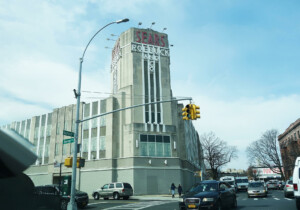In the two years since restoration work on the largely-forgotten Fort Moore Pioneer Memorial restoration in Downtown Los Angeles began, the areas around the isolated military memorial fountain have begun to see signs of change.
To the north, the LA Plaza Village project, a new mixed-use development by architects Johnson Fain and landscape architects SWA Group, will likely transform the area when its 355 housing units and 46,000 square feet of commercial spaces come online in 2018. That project will take over several Los Angeles County–owned parking lots occupying the relatively isolated blocks east of the memorial. These formerly-neglected hillside lands are populated mostly by encampments, parking lots, and planted slopes and are relatively difficult to access on foot. The LA Plaza project will feature, however, a central, stepped paseo connecting across several blocks, linking the memorial with the pedestrian life of the Olvera Street area to the east. The Civic Center area to the south of the memorial, meanwhile, is working toward implementing the initial phases of a new, transformative master plan that seeks to convert the bureaucratic enclave into a mixed-use residential neighborhood in its own right.
If there’s anything in the air around these parts, it’s change. Work on the Fort Moore Pioneer Memorial continues in pursuit of these changes, as the fountain—its waters shut off since the 1977 drought—is meticulously restored by the Los Angeles County Department of Public Works under the guidance of Conservator Donna Williams and Civic Art Collections Manager Clare Haggarty.
The memorial is located atop the stubborn slope that gives Downtown Los Angeles’s Hill Street its name and is dedicated to the Mormon Battalion and the New York Volunteer American military forces that first raised the American flag over the recently-conquered California territory on July 4th, 1847.
The memorial is situated in a sunken plaza that features a large, running-bond brick expanse on its northernmost end. Next follows the 80-foot-wide waterfall backed by small, colorful tiles. The southernmost portion of the memorial contains a 78-foot by 45-foot terra cotta bas relief installation designed by renowned German sculptor Henry Kreis depicting the flag raising ceremony mentioned above. The bas relief installation also features a trio of symbolic narrative compositions celebrating the area’s conquest via Manifest Destiny. The uppermost panel celebrates the post-indigenous Spanish ranchos and agricultural pioneers of the area. The central panel depicts a “prairie schooner,” a type of stagecoach used by the early American settlers “who made Los Angeles a city,” while the lowest panel celebrates the might of industrial “water and power” that allowed for the region to be inhabited on a mass scale.
The overall memorial was designed by Southern California architects Kazumi Adachi and Dike Nagano between 1947 and 1957 and officially dedicated in 1958. The memorial also features a 68-foot-tall triumphal pylon designed by American sculptor Albert Stewart. The pylon is itself embossed by a 16-foot by 11-foot sculpted eagle bas relief and an inscription dedicated to the “brave men and women” who played a role in “extending the frontiers” of the United States westward.
Haggarty spoke to The Architect’s Newspaper (AN) via email, explaining that work on the memorial restoration is well underway, with the restoration of the waterfall’s tile backing proceeding toward completion. Craftspeople are recreating replacement tiles for the wall by hand in an effort to match the original installation. Haggarty explained that when the waterfall was turned off during the 1977 drought, the monument began to fall into disrepair, but that many of the artistic components are in decent shape, otherwise. She explained, “The materials [like] grout, tiles, etc. started to get brittle and began to delaminate” when the water was originally shut off and that after over 40 years of neglect, “the plumbing for the waterfall needs to be entirely replaced.”
A goal of the restoration is to return the monument to its original function as a fountain, assuming there is enough water to go around. Haggarty explained, “It is supposed to be a fountain and turning it off caused most of the issues. Another big issue is graffiti and prior methods of removal that have done more harm than good.” A broad, sandblasted patch along the brick wall portion of the project is a testament to that fact.
Haggarty and Williams will both be presenting at the Los Angeles Visionary Association salon on Sunday, April 30th. The event, organized by preservation advocates Kim Cooper and Richard Schave, will include lectures from the women behind the restoration project as well as a tour of the restoration site. Schave told AN via email, “The Fort Moore Memorial is a huge part of the downtown landscape, poorly understood, and neglected, and now, thanks to the LA County Arts Commission, it is coming back into focus.” Schave added that the restoration “allows us to reassert the lost history of [Fort Moore] Hill—the demolished layers from the 19th and early 20th centuries, including the people who lived there—and the monument itself.”










